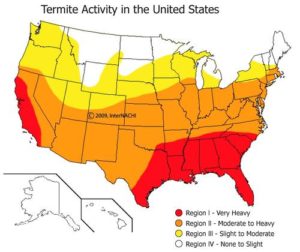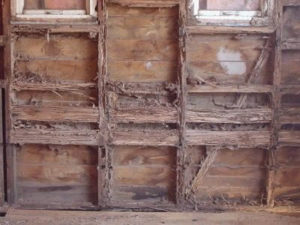Termite Inspections
What does a termite inspection entail?

A termite inspection is a visual inspection of the readily accessible areas of a home for evidence of wood-destroying insects (WDI) and wood-destroying organisms (WDO). The inspector will visually inspect the entire interior of a home (including accessing and entering any sub-space such as basements and crawlspaces) and exterior of the property. In areas where Dry wood termites are prevalent, and in houses where there are no sub-areas, the attic may also be accessed and inspected.
How long does an inspection take?
The average termite or pest inspection takes approximately 30 to 45 minutes for a thorough inspection, depending on the size and conditions (e.g. clutter; storage of personal items, etc.) of the home and property.
Can termites live in colder climates?
Yes, termites have been found throughout the United States, even in Alaska! Cold weather does not kill them off; rather it slows them down or causes them to go into a hibernation state. As a matter of fact, it has been reported that 1 out of every 15 houses in the Chicago area have termite infestations.
Why inspect the attic if termites stay close to the ground?
The termite inspection is actually an inspection for wood-destroying insectsand organisms. The inspector is also looking for ants, bugs and fungus. Sometimes, in areas where Dry wood termites are prevalent, and in houses where there are no sub-areas, the attic may also be accessed and inspected. Inspectors routinely look in the attic area for Dry wood termite pellets (fecal matter), which are oblong, vary in color from light gray to very dark brown, and are only 2 to 3 millimeters long. They generally accumulate on surfaces or in spider webs near the eaves area of the attic
What do termites look like?
 Subterranean termite colonies consist of three different castes–reproductives, workers and soldiers. All of the Subterranean termites are generally creamy white in appearance and are translucent, looking very much in size, shape and color as a grain of rice. The reproductives, or “swarmers,” have a pair of even-sized wings and are often mistaken for flying ants. The workers look similar to the “swarmers,” only they are a little smaller and do not have wings. The soldiers are also similar except for their over sized heads and large, crushing mandibles.
Subterranean termite colonies consist of three different castes–reproductives, workers and soldiers. All of the Subterranean termites are generally creamy white in appearance and are translucent, looking very much in size, shape and color as a grain of rice. The reproductives, or “swarmers,” have a pair of even-sized wings and are often mistaken for flying ants. The workers look similar to the “swarmers,” only they are a little smaller and do not have wings. The soldiers are also similar except for their over sized heads and large, crushing mandibles.
What is the difference between carpenter ants and termites?
 There are a number of differences between carpenter ants and termites. The body shape of a carpenter ant is like an hourglass–it narrows between the abdomen in the rear and the thorax in the front. The body of a termite is more cigar-shaped without the narrowing between the front and back halves of the body. When wings are present, carpenter ants have larger wings in the front and smaller wings in the back, whereas termite “swarmers” have relatively equal-sized wings. Carpenter ant wings are less “veiny” than termite wings. Also, ant wings have a stigma (dark spot) on the leading edge of the front wing, and termite wings do not. Carpenter ant antennae are bent or curved, while termite antennae are relatively straight. Also, termites eat the wood they tunnel through and ants do not.
There are a number of differences between carpenter ants and termites. The body shape of a carpenter ant is like an hourglass–it narrows between the abdomen in the rear and the thorax in the front. The body of a termite is more cigar-shaped without the narrowing between the front and back halves of the body. When wings are present, carpenter ants have larger wings in the front and smaller wings in the back, whereas termite “swarmers” have relatively equal-sized wings. Carpenter ant wings are less “veiny” than termite wings. Also, ant wings have a stigma (dark spot) on the leading edge of the front wing, and termite wings do not. Carpenter ant antennae are bent or curved, while termite antennae are relatively straight. Also, termites eat the wood they tunnel through and ants do not.
How do you treat termites?
There are several methods available to treat Subterranean termites. A chemical treatment is the most common treatment type available for Subterranean termites. The goal of a Subterranean termitechemical treatment is to establish a continuous termiticide barrier between the termite colony (usually in the soil) and wood in a building. This is done by placing termiticide in the soil on both sides of all foundation elements to provide a barrier preventing termites from entering the structure. Technicians trench the soil and inject termiticide beneath it at 16-inch intervals. They also drill into hollow masonry block foundations and inject termiticide into the block voids. This creates a protective barrier around the property.
In-ground baiting systems are also becoming a popular method for treatment of Subterranean termites. A subterranean termite baiting system involves placement of cellulose (wood material) bait stations at strategic locations around the perimeter of the home. Worker termites, which constantly forage for wood to feed their colony, locate the cellulose bait stations and leave special scent trails to summon their mates to the food source. The cellulose material in the bait station is then replaced with a chemical inhibitor, retarding the molting process in termites and preventing them from growing. The carrier termites then bring the chemical back to the colony and–if everything goes well–spread the inhibitor throughout the remainder of the colony. Because of the growth inhibitor, the carrier and the rest of the colony will die.
Could there be termite damage?

Absolutely! One of the main characteristics of termites and termite colonies is their tendency to avoid open air and bright lights, meaning they will stay underground or within wood products. It is almost impossible for an inspector to visually identify or locate an active termite infestation just by looking at the finished surface of a wall or the accompanying trim.
What can I do to prevent termite infestation?
The current standard method of preventing termite infestation on newly constructed homes is to have a pest control contractor visit the home and spray a liquid termiticide over the entire foundation area prior to the concrete being poured. The building sciences are continually coming up with new methods of infestation prevention. A homeowner could also make post-construction adjustments to the home that are less conducive to an infestation of wood-destroying insects. Common conditions that are conducive to an infestation are: earth to wood contact at support posts; cellulose debris and form boards left in the crawlspace; improper drainage away from the structure; and inadequate ventilation in the crawlspace. Correction of these conditions will greatly reduce the likelihood of an infestation.
What can I do to prevent termite infestation?
The current standard method of preventing termite infestation on newly constructed homes is to have a pest control contractor visit the home and spray a liquid termiticide over the entire foundation area prior to the concrete being poured. The building sciences are continually coming up with new methods of infestation prevention. A homeowner could also make post-construction adjustments to the home that are less conducive to an infestation of wood-destroying insects. Common conditions that are conducive to an infestation are: earth to wood contact at support posts; cellulose debris and form boards left in the crawlspace; improper drainage away from the structure; and inadequate ventilation in the crawlspace. Correction of these conditions will greatly reduce the likelihood of an infestation.
Why do I have to treat if there are no live termites?
If there is evidence of a termite infestation and no evidence of a termite treatment having been done, the inspector must report that the infestation is active, which means in need of treatment, even though no live insects were discovered.
Is a termite inspection included with the cost of a general home inspection?
No, it is not. The initial cost of a general home inspection does not include any other inspections.
Inspection Services

CORNERSTONE PROPERTY INSPECTIONS LLC
954 N Oakwood Ave
Republic, MO 65738
Phone: (417) 209-4321
Fax: (417) 708-0774
Email: cpi@cpipros.com
